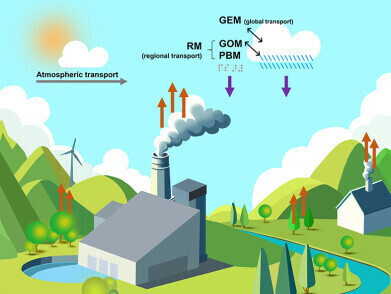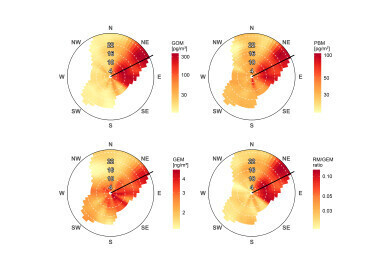-
 Figure 1: Representation of the fate of Hg emitted into the atmosphere. Hg undergoes global and regional transport, chemical transformations into reactive species, is deposited into terrestrial environments through wet and dry deposition, and is also re-emitted into the atmosphere from land, water, and vegetation.
Figure 1: Representation of the fate of Hg emitted into the atmosphere. Hg undergoes global and regional transport, chemical transformations into reactive species, is deposited into terrestrial environments through wet and dry deposition, and is also re-emitted into the atmosphere from land, water, and vegetation. -
 Figure 2: Pollution roses illustrating elevated levels of various Hg species in the vicinity of the cement plant based on observed Hg levels, wind direction, and wind speed. These species include (A) GOM, (B) PBM, (C) PBM, and (D) ratio of reactive Hg (RM = GOM+PBM) to GEM. The color scale employed here is logarithmic, with darker shades representing elevated concentration levels. The thick black line shows the angle at which the cement plant stack is located in relation to the measurement site of the study area.
Figure 2: Pollution roses illustrating elevated levels of various Hg species in the vicinity of the cement plant based on observed Hg levels, wind direction, and wind speed. These species include (A) GOM, (B) PBM, (C) PBM, and (D) ratio of reactive Hg (RM = GOM+PBM) to GEM. The color scale employed here is logarithmic, with darker shades representing elevated concentration levels. The thick black line shows the angle at which the cement plant stack is located in relation to the measurement site of the study area.
CEMS
Beyond the Stack: Emission and Dispersion of Mercury Species in the Vicinity of Cement Plant
Feb 21 2024
Mercury (Hg), a naturally occurring trace element, is released into the atmosphere through various human activities, contributing to widespread contamination of air, water, and soil. The release of Hg into the environment has severe implications for human health and ecosystems. Hg bioaccumulates in aquatic ecosystems, where it can undergo biomagnification, leading to elevated concentrations in predatory fish species consumed by humans, thereby posing a significant risk to food safety and security. Among anthropogenic emissions, the cement industry is the second largest source of Hg emission source in Europe. How does Hg come into the cement production unit? What happens to Hg once emitted into the atmosphere? Hg is brought into the cement production system from various raw materials that are ground in raw mills used for the clinker production. For energy efficiency, a part of hot exhaust gases (along with the dust particles) in the system are re-cycled back to the raw mills to dry raw materials. As a result, Hg is continuously stripped, sorbed, cycled, and enriched in the inner gas stream. When raw mills are not in operation, flue gases are not cycled back for raw materials drying, but passed directed through the fabric filter and subsequently released into the atmosphere through the kiln stack, i.e., chimney. Once emitted, atmospheric Hg undergoes various physical and chemical transformations before undergoing wet and/or dry deposition to the ground or water surfaces. Atmospheric Hg is operationally defined in three fractions: gaseous elemental (GEM), gaseous oxidized (GOM), and particulate bound Hg (PBM). They are all subject to local, regional, and global transport where GOM, and PBM have more local and regional impact whereas GEM have global effects. Knowledge on Hg emissions and speciation is critical when validating models for predicting Hg emissions, transport, deposition, and fate at local, regional, and global levels.
Our study aimed to compare Hg emissions from cement production based on the operational status of the plant's raw mill, to perform Hg speciation in a remote location near the plant, to correlate these measurements with local meteorological parameters such as wind speed and direction, and to investigate the impact of plant emissions on various Hg fractions near the study area. The study area in question is the cement plant, which has been the leading cement producer in Slovenia for over a century. Over the years, the plant has made significant investments in the utilization of alternative fuels to enhance energy-efficient production. By employing cement kilns for the co-incineration of select waste materials, provided they are free from harmful impurities and possess a high calorific value, the facility has emerged as the largest of its kind in Slovenia. This shift towards co-combustion of alternative fuels has resulted in a substantial reduction in the use of fossil fuels, such as coal, petrol coke, and natural gas, as the primary energy source. However, it is worth noting that cement plant has been met with discontent among the local population, particularly due to the co-incineration of waste. Notably, the emissions of Hg from the plant have become a matter of public concern. As part of the methodology, total gaseous mercury (TGM) concentrations in the flue gases emitted from the plant were monitored using a continuous emission monitoring system (CEMS) installed in the kiln stack during the study period. Concurrently, for continuous measurements of Hg fractions (GEM, GOM, and PBM), a Tekran Hg speciation unit coupled to the Tekran 2537B Hg vapour analyzer was deployed in the study area, situated approximately 1 kilometer southwest from the plant, in relatively close proximity to the plant chimney. This location was selected due to its alignment with prevailing wind patterns, predominantly originating from the northeastern quadrant in relation to the plant's position. Meteorological data were recorded on-site.
The study revealed that the raw mill operational status at the cement plant had a significant impact on the levels of TGM emitted through the chimney. TGM levels remained within the daily limit stipulated by DIRECTIVE 2010/75/EU of the European Parliament and of the Council of 24 November 2010 on industrial emissions. On the other hand, a clear relationship was observed between the TGM emitted from the cement plant and all Hg fractions measured in the study area. Wind direction, particularly winds blown from the northeastern quadrant, was identified as a significant factor for elevated Hg levels in the study area, with GOM levels being highly correlated with the cement plant emissions (see Figure 2). The influence of other meteorological parameters such as relative humidity and temperature on Hg levels was found out to be relatively weak. In summary, atmospheric Hg speciation in the study area, coupled with plant emissions and wind data, has revealed that TGM emitted from the cement plant is the major source of all Hg fractions measured in the study area. However, the presence of elevated Hg fractions during periods without northeastern winds from the direction of the plant chimney suggested inputs from additional local sources or contributions from regional and global transport mechanisms. Wind dynamics play a critical role in the dispersal process of atmospheric pollutants originating from point sources to surrounding regions. The study elucidates the complex interplay of wind patterns, atmospheric processes, and anthropogenic activities in influencing Hg concentrations in the Anhovo region (western Slovenia), underscoring the importance of comprehensive monitoring and mitigation strategies to address Hg contamination.
Digital Edition
AET 28.2 April/May 2024
May 2024
Business News - Teledyne Marine expands with the acquisition of Valeport - Signal partners with gas analysis experts in Korea Air Monitoring - Continuous Fine Particulate Emission Monitor...
View all digital editions
Events
Jul 30 2024 Jakarta, Indonesia
China Energy Summit & Exhibition
Jul 31 2024 Beijing, China
2024 Beijing International Coal & Mining Exhibition
Aug 07 2024 Beijing, China
IWA World Water Congress & Exhibition
Aug 11 2024 Toronto, Canada
Aug 25 2024 Stockholm, Sweden and online








.jpg)








